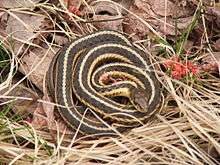Butler's garter snake
Butler's garter snake (Thamnophis butleri) is a species of garter snake in the family Colubridae. The species is endemic to North America.[1]
| Butler's garter snake | |
|---|---|
 | |
| Butler's garter snake | |
| Scientific classification | |
| Kingdom: | Animalia |
| Phylum: | Chordata |
| Class: | Reptilia |
| Order: | Squamata |
| Suborder: | Serpentes |
| Family: | Colubridae |
| Genus: | Thamnophis |
| Species: | T. butleri |
| Binomial name | |
| Thamnophis butleri (Cope, 1889) | |
| Synonyms | |
| |
Etymology
The specific name butleri is in honor of the ornithologist Amos Butler (1860-1937) of Brookville, Indiana.[2][3]
Geographic range
T. butleri is found in northwestern Ohio, northeastern Indiana, the eastern portion of the Lower Peninsula of Michigan, and the adjacent extreme southern tip of Ontario, Canada. Also, a disjunct population is found in southeastern Wisconsin.[4]
Description and identification
The butlers garter snake is a small, slender snake, averaging 38–51 cm (15–20 in) in total length (including tail), with three yellow to orange stripes along the length of its body. The background color can range from olive-brown to black, and it may also be possible to discern two rows of dark spots between the side and back stripes. These features do little to distinguish them from most other garter snakes species, but the placement of the lateral, or side, stripes is unique to this species. In Butler's garter snakes, the lateral stripes are centered on the third scale row up from the ventral scales, and they also overlap the adjacent second and fourth scale rows. This contrasts with the lateral stripe placement of other garter snake species.
For those hoping to avoid getting close enough to inspect the position of the lateral stripe, other features may help in their identification. The head is unusually small for a garter snake, and, when excited, the effort this snake expends to escape seems to go more towards thrashing in place than to getting away.
Ecology
Butler's garter snakes inhabit moist, grassy, open canopy areas, such as meadows, wet prairies, marshes, savannas and grasslands. Like Kirtland's snake, they may also be found in grassy vacant lots in suburban and residential areas. The species can often be found under rocks, logs, trash, and boards. They subsist on a diet of mainly earthworms, but they may also eat leeches, salamanders, and frogs. The species hibernates communally, often with other garter snake species. Butler's garter snakes are a relatively short-lived species, and they reach sexual maturity in their second spring.
Reproduction
T. butleri is ovoviviparous. Mating takes place in late March and early April. The young are born in June or July, in broods of four to 14.[5] The newborns are 13–18 cm (5.1–7.1 in) long.[4]
Conservation status
In Indiana, Butler's garter snake is listed as an endangered species.[6] In Ontario, the species is also listed as endangered.[7]
References
- Smith, H.M., and E.D. Brodie, Jr. (1982). Reptiles of North America: A Guide to Field Identification. New York: Golden Press. 240 pp. ISBN 0-307-47009-1 (hardcover), ISBN 0-307-13666-3 (paperback). (Thamnophis butleri, pp. 146-147).
- Cope 1889.
- Beolens, Bo, Michael Watkins, and Michael Grayson (2011). The Eponym Dictionary of Reptiles. Baltimore: Johns Hopkins University Press. xiii + 296 pp. ISBN 978-1-4214-0135-5. (Thamnophis butleri, p. 44).
- Conant, Roger. (1975). A Field Guide to Reptiles and Amphibians of Eastern and Central North America, Second Edition. Boston: Houghton Mifflin. xviii + 429 pp. + Plates 1-48. ISBN 0-395-19979-4 (hardcover), ISBN 0-395-19977-8 (paperback). (Thamnophis butleri, p. 161 + Plate 23 + Map 113).
- Schmidt, K.P., and D.D. Davis. (1941). Field Book of Snakes of the United States and Canada. New York: G.P. Putnam's Sons. 365 pp. (Thamnophis butleri, pp. 251-252).
- Indiana Legislative Services Agency (2011), "312 IAC 9-5-4: Endangered species of reptiles and amphibians", Indiana Administrative Code, retrieved 28 Apr 2012
- Ontario Ministry of Natural Resources, Butler's Gartersnake, retrieved 29 Apr 2013
Further reading
- Behler, J.L., and F.W. King. (1979). The Audubon Society Field Guide to North American Reptiles and Amphibians. New York: Alfred A. Knopf. 743 pp. ISBN 0-394-50824-6. (Thamnophis butleri, p. 664 + Plate 529).
- Cope, E.D. (1889). On the Eutæniæ of southeastern Indiana. Proc. United States Natl. Mus. 11: 399-401. (Eutænia butleri, new species, p. 399).
- Powell, R., R. Conant, and J.T. Collins (2016). Peterson Field Guide to Reptiles and Amphibians of Eastern and Central North America, Fourth Edition. Boston and New York: Houghton Mifflin Harcourt. xiv + 494 pp. ISBN 978-0-544-12997-9. (Thamnophis butleri, pp. 426–427 + Plate 42).
- Wright, A.H., and A.A. Wright. (1957). Handbook of Snakes of the United States and Canada. Ithaca and London: Comstock Publishing Associates, a Division of Cornell University Press. 1,105 pp. (in 2 volumes). (Thamnophis radix butleri, pp. 816–820, Figure 236 + Map 58 on p. 763).
External links
| Wikimedia Commons has media related to Thamnophis butleri. |
- Center for Reptile and Amphibian Conservation and Management - Indiana-Purdue University
- Butler's Garter Snake at Animal Diversity Web
- Butler’s Garter Snake, Natural Resources Canada
